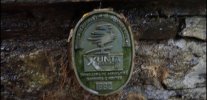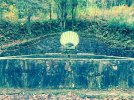-
 ⚠️ Emergency contact in Spain - Dial 112 and AlertCops app. More on this here.
⚠️ Emergency contact in Spain - Dial 112 and AlertCops app. More on this here. -
Remove ads on the forum by becoming a donating member. More here. -
Get your Camino Frances Guidebook here.
Search 74,075 Camino Questions
You are using an out of date browser. It may not display this or other websites correctly.
You should upgrade or use an alternative browser.
You should upgrade or use an alternative browser.
Fountain near Triacastela on the San Xil Route
- Thread starter Cuttooth
- Start date
...and ship it to Santiago for storage. You pick it up once in Santiago. Service offered by Casa Ivar (we use DHL for transportation).
zenofmatthew
Member
- Time of past OR future Camino
- 10/4/21 - 10/12/21 Vega to Santiago.
Built by the nuns of St Xil in 1497, this fountain has served as beacon to travelers, bringing them away from the brothers at Samos.
Nah - just being funny. We arrived at sunrise and the reflection on the fountain was wonderful. I thought there was a sign next to it, but alas my memory is on the sunshine not the sign.
- just being funny. We arrived at sunrise and the reflection on the fountain was wonderful. I thought there was a sign next to it, but alas my memory is on the sunshine not the sign.
Nah
- Time of past OR future Camino
- Frances\Finisterre 22 Frances 26 del Norte 27
Holoholo automatically captures your footpaths, places, photos, and journals.
Cuttooth
Member
- Time of past OR future Camino
- Camino Frances (2016), (2020), (2022)
You had me going there for a hot minute.... I was thinking - those were some crafty sisters ;-)Built by the nuns of St Xil in 1497, this fountain has served as beacon to travelers, bringing them away from the brothers at Samos.
Nah- just being funny. We arrived at sunrise and the reflection on the fountain was wonderful. I thought there was a sign next to it, but alas my memory is on the sunshine not the sign.
The first edition came out in 2003 and has become the go-to-guide for many pilgrims over the years. It is shipping with a Pilgrim Passport (Credential) from the cathedral in Santiago de Compostela.
- Time of past OR future Camino
- To Santiago and back. Le Puy to Aumont-Aubrac.
Anyone know the story about the fountain in the image below?
View attachment 131683
I guess if there were much of a story to tell about this fountain it could be found in "The Complete Cultural Handbook" about the Camino de Santiago by David Gitliz and Linda Davidson.
Their account is short: It is the modern Fuente Vieira, remodelled for the Holy Year 1993.
And (translated) from a Spanish blog: This was originally a simple water pipe/spout that still remains, but for the 1993 Holy Year, it was adorned with a huge scallop, and a large stone bench was placed around it.
Last edited:
- Time of past OR future Camino
- To Santiago and back. Le Puy to Aumont-Aubrac.
There is. I didn't notice the plaque but at least one person took a photo once. The text is difficult to read but one can make out the words Xunta - "Government", with "Galicia" beneath it perhaps - and then the words Conselleria de Agricultura, Ganaderia y Montes - "Department for Agriculture, Lifestock Farming and Mountains" - followed by "1992". The Holy Year 1993 was the year for which the regional government of Galicia had heavily promoted the Camino de Santiago to attract Spanish and international visitors to Galicia. It is the year when the contemporary Camino de Santiago really took off as an international destination. The fountain was presumably financed in the context of a program for rural development - hence the department for agriculture is named and not a department for culture or religion or tourism.I thought there was a sign next to it
So there is a story to the fountain after all. More recent and more prosaic than expected perhaps but a story nevertheless.

Last edited:
The 2024 Camino guides will be coming out little by little. Here is a collection of the ones that are out so far.
Cuttooth
Member
- Time of past OR future Camino
- Camino Frances (2016), (2020), (2022)
There is. I didn't notice the plaque but at least one person took a photo once. The text is difficult to read but one can make out the words Xunta - "Government", with "Galicia" beneath it perhaps - and then the words Conselleria de Agricultura, Ganaderia y Montes - "Department for Agriculture, Lifestock Farming and Mountains" - followed by "1992". The Holy Year 1993 was the year for which the regional government of Galicia had heavily promoted the Camino de Santiago to attract Spanish and international visitors to Galicia. It is the year when the contemporary Camino de Santiago really took off as an international destination. The fountain was presumably financed in the context of a program for rural development - hence the department for agriculture is named and not a department for culture or religion or tourism.
So there is a story to the fountain after all. More recent and more prosaic than expected perhaps but a story nevertheless.
View attachment 131707
Prosaic as it may be it is exactly what I was looking for! Thank you for taking the time to relay the story.
zenofmatthew
Member
- Time of past OR future Camino
- 10/4/21 - 10/12/21 Vega to Santiago.
This isn't the sign I remember, but thinking back on things, no way was there a rectangular sign similar to the roadside ones we see in the US. Faulty memory provenThere is. I didn't notice the plaque but at least one person took a photo once. The text is difficult to read but one can make out the words Xunta - "Government", with "Galicia" beneath it perhaps - and then the words Conselleria de Agricultura, Ganaderia y Montes - "Department for Agriculture, Lifestock Farming and Mountains" - followed by "1992". The Holy Year 1993 was the year for which the regional government of Galicia had heavily promoted the Camino de Santiago to attract Spanish and international visitors to Galicia. It is the year when the contemporary Camino de Santiago really took off as an international destination. The fountain was presumably financed in the context of a program for rural development - hence the department for agriculture is named and not a department for culture or religion or tourism.
So there is a story to the fountain after all. More recent and more prosaic than expected perhaps but a story nevertheless.
View attachment 131707
Thanks a lot @Cuttooth - now I'm busy remembering this crazy fountain and that mornings proceedings.
❓How to ask a question
How to post a new question on the Camino Forum.
Most read last week in this forum
Ok so ... this past spring (2024) I decided to walk the "lower" route into Pamplona and became really lost. I just keep thinking about it and it really bugs me. Where did I go astray?
At the...
Hi all,
doing the Camino Francés was one of my childhood dreams. I grew up hearing epic stories about it, and wanted to be a part of it.
Like everyone, however, I have my quirks, and wanted to...
I asked the tourist office for information about the statue of the pilgrim at the entrance to Carrión de los Condes. Here is their reply. auto-translated: "The Monument to the Pilgrims" is a...
I understand that footwear on the Camino is a personal choice. I will start my first Camino on the Camino Frances in the first part of April. With the varying weather conditions, what...
Hello. Earlier this year I saw photos of the streets being decorated for Corpus christi and I'm thinking that when I do my next camino, probably 2026, that it would be nice to help with the...
Hello, I am looking to continue a segment of the Camino Frances, that I started 10 years ago. I would be starting back up in Burgos.
Is it possible to do this in January ? It seems like the...
Similar threads
- Replies
- 1
- Views
- 531
- Replies
- 16
- Views
- 2K
- Replies
- 4
- Views
- 601
- Replies
- 2
- Views
- 961
❓How to ask a question
How to post a new question on the Camino Forum.
Most downloaded Resources
-
“All” Albergues on the Camino Frances in one pdf“All” Albergues on the Camino Frances in one pdf
- ivar
- Updated:
-
A selection of favorite albergues on the Camino FrancésFavorite Albergues along the Camino Frances
- Ton van Tilburg
- Updated:
-
Profile maps of all 34 stages of the Camino FrancesProfile maps of all 34 stages of the Camino Frances
- ivar
- Updated:















